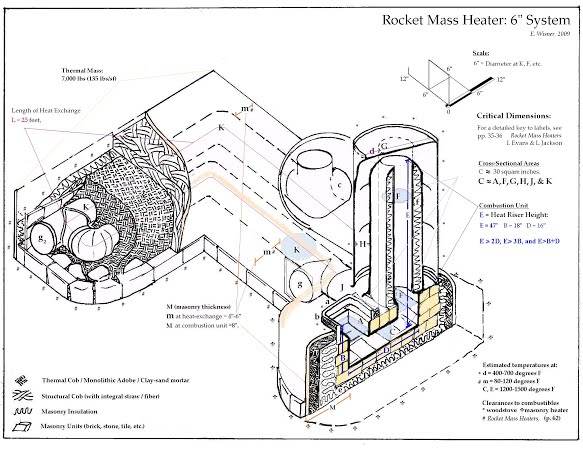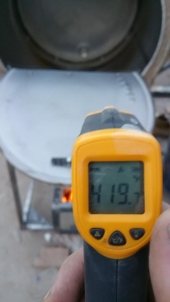A
Table of Contents, by request, giving some useful links to popular questions that have already been answered.
Hopefully looking here first will save you time. And of
course, make us all look well-informed and smart. Isn't that why we're here, after all?
There are also some search tips below if your question isn't listed yet here.
(
click for full-sized image)
The Theory (or, what's that?):
Intro threads:
Rocket Mass Heater exhaust can be simpler than a chimney (Editorial note: this is a good general introduction, but see also later posts about why non-vertical or too-short chimneys can be unreliable.)
Terms and types of rockets -
Rocket Mass Heaters vs. Scandinavian / Slavic Masonry Heaters
- J-tube or J-type firebox = the Evans-style rocket firebox with a down-drafting
feed, horizontal burn tunnel, then taller vertical firebox, shaped like a san-serif J but square. Most Wisner
heaters are J-type.
--- heat riser = insulated vertical portion of firebox to promote clean burn, sets minimum height requirements for working
rocket mass heaters
--- burn tunnel = the horizontal portion of a J-type firebox, between the feed and the heat riser
- L-tube or L-type: a simple
rocket stove firebox with a short, horizontal firebox/burn tunnel, and a vertical heat-riser. Mostly used for cookstoves as they don't burn clean
enough for rocket mass heaters; most Approvecho stoves are L-type.
-
Batch box = High-volume models with a larger, horizontal
wood feed, which burn clean enough for safe heat recapture due to several clever and necessary refinements. See posts by Canyon/Donkey/PeterBerg/Walker, and watch for the link to the proboards.com forum for dimensional tables.
-
manifold (common to most system types) = junction between barrel and bench pipes, often through a space constructed immediately below the barrel. This
thread has good pics of two ways to do them:
length-exhaust-pipe-mass
- heat-exchange channel = sealed path that carries hot exhaust through mass, usually made with stovepipe or ducting (may also be refractory masonry as for other masonry heaters)
- bell = an oversized cavity with some height to it, which holds hot air/exhaust at the top, and allows cool/warm air to escape through a hole near the bottom, using natural stratification. See also
Bell-explanation (proboards.com)
- mass, bench, heat-exchange mass = the masonry or other material that stores heat, without mass it's just a
rocket stove, not a
rocket mass heater. Benches or beds dominate as in the original design, allowing comfortable full-body heating contact with the mass, and reducing the problems and expense of foundation requirements by spreading out the weight over a larger area.
- horizontal run max length - depends on climate and what your performance standards are, but the Wisner's recommendations for max length are:
Erica's reply here;
Ernie's post here. Stoves with 15 to 20 feet of pipe length can also work out fine, and a few people have built pipes 60 or even 70 feet long in special circumstances. I think they defined success as "hey, it burned (at all)!".
- critical proportions (heat riser height e.g.) -
RMH CSA questions (J-type) PeterBerg Batch Box Dimensions (proboards.com)
- why not to use metal -
"fireboxes.... size and type ?'s",
- exit chimneys -
rocket mass heater without a chimney is it possible RMH-flue-fires
- cost (DIY vs. installed) -
Cost estimating for rocket mass heaters
See also proboards.com library,
glossary of terms.
Sites and Situations:
off-grid homes/cabins / yurts
basement / suspended wood floor (often these are two alternatives for the same building) -
Basement
greenhouses/aquaponics -
Greenhouse-Rocket-Stove (with aquaponics hijack);
Rocket Stoves in Greenhouses, our own forum topic (the big mamma - 7 pages and counting!)
Insurance / codes:
Complying with building codes (UK and US info intermixed)
Heating Load / What size do I need?
Ordinary to efficiency homes, moderate to cold climates (like the US or southern Canadian provinces) - almost all threads unless otherwise indicated. e.g.
RMH in new stick built construction
Big buildings / very cold climates -
Results of the 8" Batch Box Thingy at Innovator's Gathering North Pole Alaskan rocket stove
tiny homes / rather warm climates -
Rocket mass heaters for Texas? and warm climates generally Mini mass heater (Chris Burge) Success story, 4" RMH for my workshop
Portable campers / tipis /
Manufactured homes - maybe the portable style one's Paul's been working on, with better non-combustible materials?
---
Outside Air for RMHs? Not necessarily
Intermittent use areas, like vacation homes / shops / chapels - maybe you don't need mass storage (wastes heat after you leave), but on-demand radiant heat?
Materials and Methods:
different mixes for different areas:
thermal
cob, straw-cob (structural cob), perlite-cob, clay slip, clay-sand mortar, refractories, insulation
Paul's "cobbish" perlite-clay with added fiber,
shippable core
what kind of bricks -
"Fake Fire Brick"
barrel seal
MATERIAL SOURCING (discusses manifold / mortar seals) another newbie question about the core (discusses barrel-to-barrel seals)
fuel -
What is the best way to grow fuel for a RMH - note that you can also use ordinary cordwood, split (or not) to any size that fits in the firebox.
manifold/transition area
mass coatings (finishes) -
Primer on cob plasters - or you can build a masonry box as a one-step outer surface and infill with mortar/cob/dirt around the pipes - or you can build a hardee-backer box (and plaster or tile it if you like). Matt Walker's been doing some unconventional finishes for his lower-mass outdoor benches, e.g. cast-cement tops and cement-board sides:
Multifunction-outdoor-rocket-system
what kind of insulation
refractories / castable refractories
Operation / New Systems:
condensation in system -
Peter's post on thread, "I need help ... My rmh is giving me 3lts of water a day in the exhaust pipe" (note: don't use the corrugated pipe shown in this project!)
how long until the cob is dry
rocket temps -core-barrel-bench-flu ...
chimney temps and exhaust corrections -
Need for a conventional smoke stack on a rocket mass heater
Search Suggestions:
If your question isn't here, and if you're new: this is what I've found useful to find specific info on these forums.
1) Read and Search: Click around threads like this one, and use the "Search" function (above-right on your screen) to look for posts about your question or
project idea. I usually pick one or two key words, like "rocket" plus "Basement" or whatever, and then add more terms if I get too many answers. Searching using someone's name who looks like they know what they're talking about can sometimes help find good threads, too. (see below, for this topic).
If your question has already been answered somewhere on this forum, searching first means a) you can learn what you need sooner, b) you may get a more complete answer due to multiple responses or clarification from different levels of
experience, and c) there are probably a lot of interested people following the older thread, so you may be able to piggy-back your follow-up question for a faster response. Please keep follow-up questions relevant to the main thread; if it's a separate conversation, start a new thread.
2) Post your own questions, project photos, etc. Most questions will do best as a new thread, but if you found most of
the answer on an older thread and you just need to clarify something, go ahead and piggyback by posting the clarifying question to that thread. Pictures and a little bit of situation background make it easier for members to give relevant answers. You need to register to post, it's free. To get pictures or diagrams into your post you'll need to host them online somewhere else, such as a free blog or photo-album service. You can also link to other people's pictures from anywhere online. Just copy the "image location" from the online source, click on "Img" while writing your post, and paste the link in. I like pictures about 600 px wide.
3) The 48-Hour Rule: The Permies.com policy is that if you don't get an excellent answer within 48 hours, you can post a link to the unanswered question to the "Tinkering with this Forum" area with "Invoking the 48-Hour Rule" in the subject line, and the moderators will personally ensure that you get an excellent response. Note that this doesn't mean any particular member or moderator is obligated to answer or review your questions in detail, or to provide free professional-level consulting, but we will do our best to get you useful and accurate information, resource links, or reference suggestions.
Self-Rating Encouraged:
If you feel like you know a good thread when you see it, because you have built a few rocket heaters yourself and know what's critical to success, then please feel free to post your favorite resource threads to this sticky thread as you see fit.
(Folks mentioned by name below, I'm looking at you!

)
If you have not built or lived with rocket mass heaters and are therefore not sure whether a particular thread's answers are accurate, your help is still valued. Two options: you can PM me or one of the folks below with the link to the thread, and ask for it to be checked out for possible listing here. Or, if you think it's an awesome thread regardless of accuracy, you can post it here and make any comments you see fit regarding its accuracy. I do not promise to personally vet all resources, so there may be some un-checked rumors up here along with the good stuff. Nature of free info on the internet, c.e.
Experts / Experienced Sources:
Among those who regularly participate on these forums, I personally consider the following people as experienced builders or experts, and would trust their recommended links without review. (Note that they may still conduct experiments that scare me to death! but they have enough experience to speak for themselves, rather than being subject to my review.)
One great search tactic that I often use myself is to include their name, or part of their name, as an additional search term when you are looking up a question.
- Ernie Wisner - nuances of J-type performance and natural materials; answers without unnecessary numbers
- Peter van den Berg, aka Peter Berg - both J-type and batch box; answers with numbers
- Kirk Mobert, aka "Donkey" - natural building with site-sourced materials, reports from other sources such as his ProBoards forum
- Matt Walker, aka "Walker Stoves", aka "BroAudio" on youtube: batch heaters, investigation into US code compliance
-
Water Heating: Tim Barker, Caleb Larson
- Pellet feed/hopper: Rob Torcelli
- Portable/heater-in-a-box prototypes: Paul Wheaton
- Warm-climate heaters: Adiel Shnior
- Any authors or assistants mentioned in the Evans/Jackson publication,
Rocket Mass Heaters, any edition; these include the backyard tinkerers, whose advice is on a worked-for-them basis. Lasse Holmes aka "Canyon" (Alaska-size heaters), Flemming Abrahamsson (masonry heaters & architecture), Bernhard Masterson (physics/Cob Cottage style bench heaters), Leslie Jackson (pocket rockets mainly), and of course Ianto Evans himself (unlikely to be posting here, alas).
There are lots of other good builders, engineers, heater-owners, and great students on these forums who have useful expertise to contribute. The list can't ever be complete, so I'll stop there for now.
Satamax Antone often posts very good links and brief, relevant answers. I can't personally speak to his building expertise, but it's clear he's following the online research closely.
Allen Lumley is an enthusiastic and helpful member, who has helped build at least one heater. Sometimes his answers are confusing or over-generalized, but he often starts very useful discussions. And as he's probably got one of the highest post-counts on this forum, I'm hoping he'll nominate some favorites!
-Erica Wisner

 14
14





 )
)
 2
2




 2
2





 4
4




 2
2




 ! )
! ) 3
3














